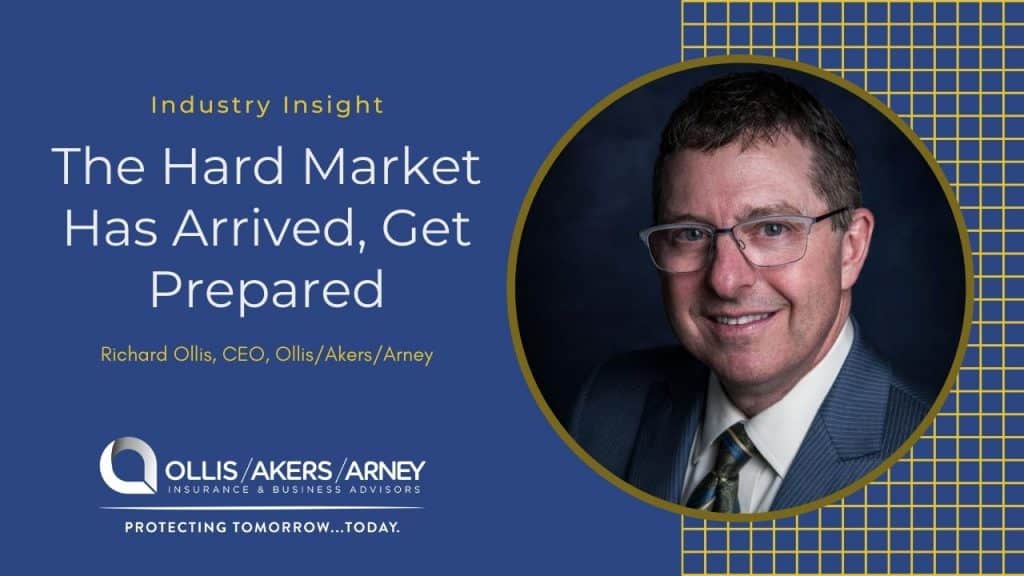As we move into the second half of 2020, our battle with COVID-19 continues. Businesses are rightfully focused on this challenge and may not be prepared for another obstacle they are facing – the hardening commercial insurance marketplace. The “hard” market is causing premiums to rise and coverages to become more restrictive. We haven’t experienced an insurance market like this since 9-11-2001.
In stable economic conditions, insurance coverages and pricing are normally available and competitive, constituting a “soft” market. The longest economic expansion in history, ending in February 2020, previously brought steady premium pricing and readily available coverage, terms, and conditions. The industries long standing “soft” market was long lived, spanning nearly two decades.
Headwinds of this market shift were well underway prior to COVID and the economic volatility associated with it. A changing legal climate, rising catastrophic claims, and inadequate pricing started this trend towards a “hard” market in 2019.
Here’s why the market is shifting:
Over the past several years, volatile weather has adversely impacted the industry. Floods, hurricanes, wildfires, wind, and hail have become increasingly more common and devastating. Munich Re estimates catastrophic losses of $52 billion in 2018. As a comparison, 2013, 2014, and 2015 (3 years) combined totaled $44 billion.
The legal climate has also become exceptionally challenging. Nuclear verdicts (one that surpasses $10 million) have become an all-too-real trend. In 2019, according to Liberty Mutual, the largest jury verdict amounted to more than $8 billion in awarded damages. In that same article, corporate mistrust, litigation financing, and social inflation were listed as significant emerging factors. Social inflation is especially troubling for many businesses as this is a societal trend that favors increased litigation, broader contract interpretations and larger jury awards. Just turn on the television and you’ll experience a barrage of plaintiff attorney ads.
Costs to re-construct buildings, replace equipment, and repair vehicles have also contributed to rising costs. According to Richard Lara, CEO of RAAM Construction, costs climbed another 5% in 2018 with material costs alone rising 10%. Material costs, labor, and the impact of tariffs continued to rise in 2019 causing another significant increase in construction costs. This compounding effect over several years has left many businesses and insurance companies underinsured and ill-prepared for a loss to property.
The insurance industry itself is not immune to economic conditions. Inconsistent underwriting profits over the past several years driven by rising losses and inadequate risk pricing have caused most all companies to re-evaluate their pricing models. Eroding investment returns have also had an impact. As importantly, insurance companies buy re-insurance which has become more expensive.
All of these converging factors are causing two major shifts:
- Pricing is on the rise for commercial insurance programs
- Coverage terms and conditions are constricting
Certain industries and geographic regions are being impacted more severely than others, but few will be immune to this changing marketplace.
Here’s what to expect and how to deal with it:
- Auto pricing, particularly for large fleets of trucks or vehicles is rising – expect increases of 6-12%. Effective fleet safety programs coupled with strong driver training and monitoring can mitigate the impact.
- Directors and Officers/Employment Practices is being adversely impacted, especially for larger and public companies. Expect 5-50% increases for public companies, 5-25% for privates. Effective human resource practices, board protocols, and strong management lessen this trend.
- Commercial property coverage is being impacted in several ways. The rising cost of construction is making it critical to increase insured values. In the mid-west, larger wind/hail deductibles are being demanded by carriers, particularly on large property schedules where pricing is rising. Expect increases of 10-25%. Well maintained, sprinklered property that’s been insured to value, coupled with good loss experience can help drive pricing to the bottom end of this pricing band.
- Umbrella Liability is very volatile. Large auto/truck fleets, hazardous liability exposures and poor experience can make it difficult to find adequate liability limits. Many businesses are layering multiple carriers to obtain the needed coverage. Expect increases of 10-50% depending on industry and experience.
It’s especially important to have and to hire experts to guide a business through these challenging circumstances. Positioning your business to mitigate the impact of the changing marketplace is critical. An experienced, capable insurance consultant can be invaluable in providing a plan to improve performance and be a business advocate to the marketplace.
The commercial insurance marketplace is changing. If not positioned properly, businesses will suffer from increased pricing and restrictions in coverage. Preparation coupled with sound risk management and communication can vastly improve your odds of weathering the headwinds of this significant shift.
Original article was posted August 3, 2020 on SBJ.net.


